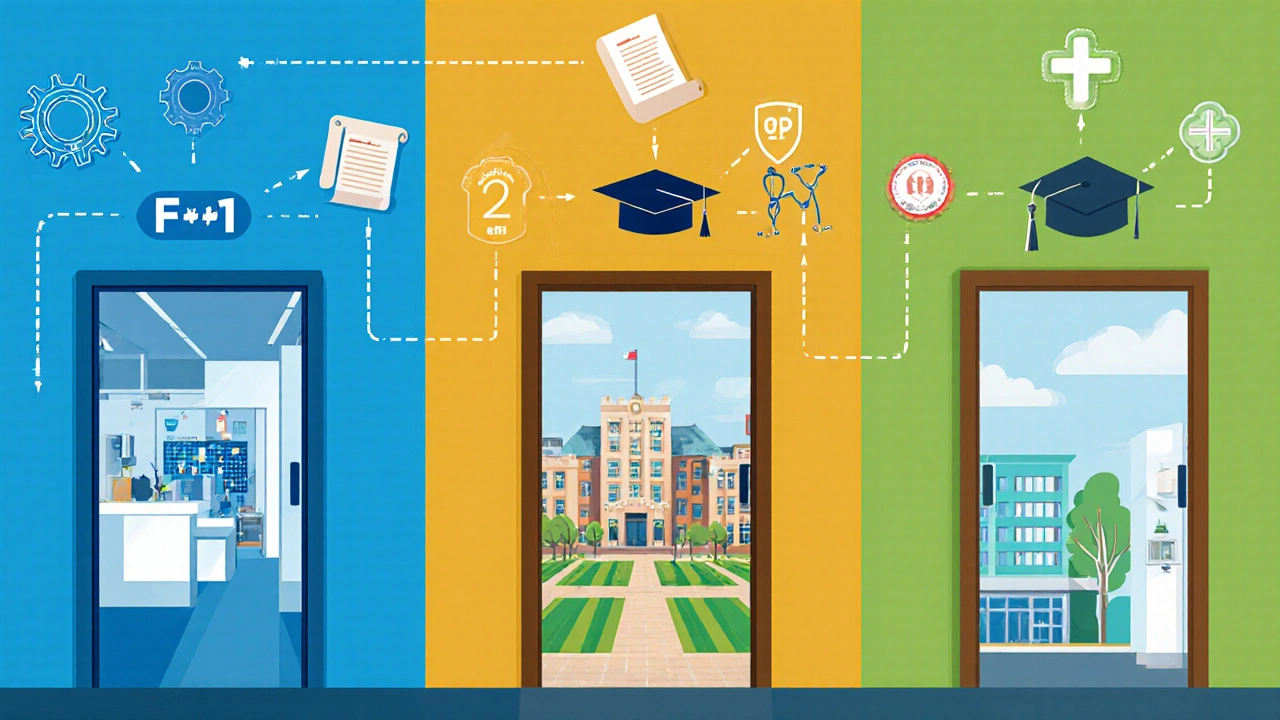Best Diploma Options for Studying and Working in the USA

Trying to pick the right diploma that opens doors in the United States can feel like solving a puzzle with missing pieces. Do you need a quick, job‑ready credential, or are you aiming for a degree that boosts long‑term career growth? Below you’ll find a step‑by‑step guide that matches diploma types to U.S. immigration routes, costs, and job prospects so you can decide what truly works for you.
Quick Takeaways
- Associate degrees from community colleges are the fastest path to work‑eligible visas for technical fields.
- Bachelor’s degrees are preferred for H‑1B sponsorship and long‑term career advancement.
- Professional diplomas in health‑care, IT, and skilled trades can qualify for the STEM OPT extension.
- Accredited U.S. institutions (regional accreditation) are essential for visa eligibility.
- Cost varies widely: community college associate programs average $5,000‑$15,000, while private universities can exceed $60,000 per year.
Understanding the Core Entities
Before diving into comparisons, let’s define the main pieces you’ll encounter.
Diploma is a formal certification awarded by an educational institution that validates completion of a specific program of study. In the U.S., diplomas can range from short‑term trade certificates to two‑year associate degrees and four‑year bachelor’s degrees.
Associate Degree is a two‑year undergraduate credential typically offered by community colleges and some four‑year universities. It focuses on either an academic transfer pathway or a career‑oriented associate of applied science (AAS) track.
Bachelor's Degree is a four‑year undergraduate qualification that provides a comprehensive education in a chosen major and is the most common prerequisite for professional work visas such as the H‑1B.
Professional Diploma is a specialized, often industry‑specific credential that sits between a certificate and a degree. Examples include nursing diplomas, IT networking diplomas, and automotive technology diplomas.
Community College is a publicly funded two‑year institution that offers associate degrees, vocational training, and transfer pathways to four‑year universities.
University is a higher‑education institution that offers bachelor's, master's, and doctoral programs, often with research facilities and broader campus resources.
F-1 Student Visa allows foreign nationals to study full‑time at accredited U.S. schools. It also grants eligibility for Optional Practical Training (OPT) after graduation.
H-1B Work Visa is a non‑immigrant visa for specialty occupations that typically requires at least a bachelor's degree or equivalent work experience.
How Diploma Type Shapes Your Immigration Path
U.S. immigration law ties education level directly to the type of visa you can obtain. Here’s a quick map.
- Associate Degree: Enables the F‑1 visa with eligibility for up to 12 months of OPT (or 24 months if the program is STEM‑designated). Many employers sponsor H‑1B later if you upgrade to a bachelor’s.
- Bachelor's Degree: Directly meets the minimum education requirement for the H‑1B. After graduation, you can use 12 months (or 36 months for STEM) of OPT before H‑1B filing.
- Professional Diploma: If the diploma is from an accredited program in a STEM field, you can also benefit from the 24‑month STEM OPT extension. However, most non‑STEM diplomas only grant the standard 12‑month OPT.
Remember, the visa-issuing government looks for regional accreditation as proof of quality, so always verify that your school holds this status.
Cost vs. Return: What to Expect Financially
Money matters. Below is an overview of average tuition, living costs, and potential earnings for each diploma tier.
| Diploma Type | Typical Tuition (USD) | Program Length | Average Starting Salary (USD) | Visa Pathways |
|---|---|---|---|---|
| Associate Degree (Community College) | $5,000 - $15,000 | 2 years | d>$45,000 - $55,000 (technical fields)F‑1 → OPT (12‑24mo) → H‑1B (possible) | |
| Bachelor's Degree (University) | $20,000 - $60,000 per year | 4 years | $60,000 - $80,000 (broad range) | F‑1 → OPT (12‑36mo) → H‑1B |
| Professional Diploma (STEM) | $10,000 - $30,000 | 1‑2 years | $50,000 - $70,000 (industry specific) | F‑1 → STEM OPT (24mo) → H‑1B (if qualifies) |
While tuition is a big factor, also consider hidden costs: books, health insurance, and living expenses, which can add $10,000‑$20,000 per year depending on location.
Top Fields Where a Diploma Leads to Strong Job Prospects
Not all diplomas are created equal in the eyes of U.S. employers. Here are the sectors where a U.S. diploma (or equivalent) gives you a clear edge.
- Information Technology: Network administration, cybersecurity, and cloud‑services roles often accept associate degrees or professional diplomas, especially if the program is STEM‑approved.
- Healthcare: Nursing diplomas, radiology, and medical‑technology certificates are in high demand. Many hospitals sponsor visas for qualified graduates.
- Advanced Manufacturing: CNC machining, robotics, and industrial maintenance diplomas pair well with the skilled‑trade shortage in the Midwest.
- Business & Finance: A bachelor’s in accounting or business administration remains the gold standard for corporate roles and H‑1B eligibility.
- Construction & Trades: Electrician, plumber, and HVAC diplomas from accredited trade schools accelerate entry into apprenticeship programs that can lead to green‑card pathways.

Choosing the Right Institution
Accreditation is the gatekeeper. Look for schools that carry regional accreditation (e.g., Middle States, New England, Southern). Nationally accredited career schools may still offer quality programs, but they can limit visa eligibility.
Here’s a quick checklist when researching schools:
- Verify regional accreditation on the Council for Higher Education Accreditation site.
- Confirm the program’s STEM designation if you need the extra OPT extension.
- Check the school’s international student office-strong support improves visa filing success.
- Compare tuition, scholarship options, and on‑campus employment policies.
- Read alumni reviews for job placement rates in your target industry.
Step‑by‑Step Plan to Secure Your Diploma and Visa
- Define Your Career Goal: Identify the industry you want to work in and the typical credential required. For IT, an associate degree may suffice; for corporate finance, aim for a bachelor’s.
- Research Accredited Programs: Use the checklist above to shortlist 3‑5 schools that match your budget and timeline.
- Apply for Admission: Gather transcripts, English proficiency scores (TOEFL/IELTS), and any prerequisite coursework.
- Obtain an I‑20 Form: Once admitted, the school issues an I‑20, the key document for the F‑1 visa application.
- File for the F‑1 Visa: Schedule a DS‑160, pay SEVIS fee, and attend the consular interview. Bring proof of finances and ties to your home country.
- Study and Complete Your Diploma: Maintain full‑time enrollment to keep visa status.
- Apply for OPT: Submit Form I‑765 up to 90 days before graduation. If eligible for STEM, file for the 24‑month extension.
- Seek H‑1B Sponsorship: Use your OPT period to find an employer willing to sponsor. The H‑1B lottery opens in April each year.
- Plan Long‑Term Residency: After 3‑5 years on H‑1B, consider PERM labor certification for a green card.
Following this roadmap keeps you on track and reduces surprises at each immigration checkpoint.
Potential Pitfalls and How to Avoid Them
- Choosing a Non‑Accredited School: Visa officers may reject your application if the institution isn’t regionally accredited.
- Skipping the STEM Designation: Without it you lose the 24‑month OPT boost, which can be crucial for H‑1B timing.
- Underestimating Living Costs: Many students focus on tuition alone; budgeting for rent in high‑cost cities like New York or San Francisco can prevent financial stress.
- Late OPT Filing: Missing the 90‑day window before graduation forces you to wait a full year for another chance.
- Relying on One Visa Path: Keep backup plans-e.g., O‑1 for extraordinary ability or L‑1 for intra‑company transfers.
Cheat‑Sheet: Diploma Decision Matrix
Use this quick matrix to match your priorities with the best diploma option.
| Priority | Fastest Path (1‑2yrs) | Highest Salary Potential | Best for H‑1B | Most Flexible Visa |
|---|---|---|---|---|
| Time to Enter Workforce | Associate Degree (Community College) | Bachelor's Degree (University) | Bachelor's Degree (University) | Professional Diploma (STEM) |
| Cost Sensitivity | Associate Degree (Community College) | Bachelor's Degree (University) | Professional Diploma (STEM) | Associate Degree (Community College) |
| Industry Specificity | Professional Diploma (Healthcare, IT) | Bachelor's Degree (Business, Engineering) | Bachelor's Degree (Specialized majors) | Professional Diploma (STEM) |
Next Steps for Different Personas
If you’re a recent high‑school graduate, start with a community college associate degree in a high‑demand trade. Secure the F‑1 visa, complete the program, and leverage the 12‑month OPT to land a job that could sponsor your H‑1B.
If you already hold a bachelor’s degree abroad, consider a U.S. professional diploma in a STEM field to qualify for the 24‑month STEM OPT extension, which gives you extra time to transition to an H‑1B.
If you’re a working professional seeking a career switch, a fast‑track professional diploma (e.g., data‑analytics bootcamp with credit‑transfer options) can provide the credentials and visa flexibility you need.

Frequently Asked Questions
Can an associate degree lead directly to a green card?
Not directly. You first need an F‑1 visa, then OPT, followed by H‑1B sponsorship. After a few years on H‑1B, your employer can start the PERM labor certification, which is the first step toward a green card.
Is a professional diploma considered a degree for H‑1B purposes?
Only if the diploma is recognized as a “specialty occupation” equivalent to a bachelor's degree. Most H‑1B petitions rely on a bachelor’s, but a strong STEM‑focused diploma combined with relevant work experience can be accepted.
Do I need a separate visa for OPT?
No. OPT is a work authorization attached to your F‑1 status. You file Form I‑765, and once approved, you can work without needing a new visa.
Which states have the lowest tuition for community colleges?
States like Texas, Florida, and Arizona often have community college tuition below $5,000 per year for in‑state residents and competitive rates for out‑of‑state students.
How long does the H‑1B petition process take?
After the lottery, USCIS typically takes 3‑6 months for regular processing. Premium processing shortens it to 15 calendar days for an extra fee.
Choosing the best diploma USA isn’t a one‑size‑fits‑all decision. Align the credential with your career timeline, budget, and the visa route you prefer. Follow the steps above, verify accreditation, and you’ll be well on your way to studying, working, and possibly staying in the United States.

Post-Comment